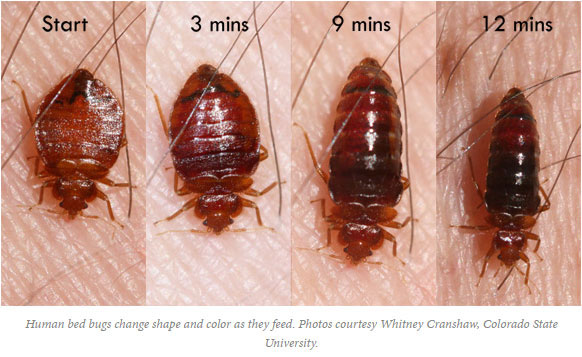A1 Bed Bug Exterminator Houston: Reliable Treatment Services
Wiki Article
Recognizing the Lifecycle of Parasites for Targeted Control Approaches
Understanding the lifecycle of bugs is a fundamental element of effective parasite management strategies. Through a much deeper understanding of just how bugs develop and thrive, customized control methods can be made to deal with details points in their lifecycle, inevitably leading to more successful insect monitoring outcomes.Value of Recognizing Bug Lifecycle
Comprehending the lifecycle of parasites is essential for establishing effective and targeted control techniques in insect administration. By understanding the numerous phases a parasite goes via from egg to grownup, bug control experts can identify susceptible factors in the lifecycle where treatment can be most effective.Additionally, identifying the certain ecological conditions needed for each and every phase of the insect's lifecycle can assist decisions on habitat modification or exemption techniques to interrupt the lifecycle and decrease pest populaces. This expertise makes it possible for pest monitoring specialists to carry out positive steps instead of relying only on responsive treatments, leading to even more lasting and sustainable bug control options. Ultimately, a complete understanding of insect lifecycles encourages bug control professionals to tailor their strategies successfully, reducing environmental effects and making the most of control results.
Trick Phases in Bug Growth
To properly apply targeted control strategies in parasite monitoring, a vital aspect lies in thoroughly determining and recognizing the vital stages in insect advancement. Parasite growth typically includes several essential stages that are vital for their lifecycle and monitoring. The initial stage is the egg phase, where insects lay eggs that later on hatch out into larvae. Larvae after that advance right into pupae, a phase where they undergo metamorphosis prior to arising as grown-up bugs. Comprehending these stages is necessary as it aids in determining at risk factors in the lifecycle where control procedures can be most efficient.

Susceptabilities in Pest Lifecycle
Throughout the different phases of a bug's lifecycle, distinctive vulnerabilities arise that can be strategically targeted for efficient control actions. One vital vulnerability hinges on the egg phase, where insects are usually much more prone to certain insecticides or biological control representatives due to their soft outer covering, making them easier targets for intervention. Furthermore, the larval or nymph stage provides susceptabilities as pests undergo fast growth and advancement, requiring high energy intake that can be made use of by disrupting their food resources or introducing growth preventions. Pupal phases, characterized by immobility and change, use a home window for targeted control via physical barriers or specific treatments that hinder successful emergence. Grown-up parasites, while more resilient due to their reproductive capacity, can still be vulnerable during breeding or egg-laying tasks, which can be interfered with via scent traps or sterilization techniques. Comprehending these vulnerabilities in the pest lifecycle is important for developing efficient and precise control strategies that effectively take care of bug populations while reducing ecological influence.Applying Targeted Control Steps

Applying targeted control steps commonly includes a multi-faceted method. This might include environment modification to make the atmosphere much less congenial to parasites, such as eliminating standing water for insect control or sealing entrance factors for rodents. In addition, biological control approaches can be used, where all-natural predators or microorganisms are presented to keep click to read more bug populations in check.
Integrated Bug Administration (IPM) techniques that combine various control actions in a worked with and lasting way are frequently the most effective in achieving long-term parasite monitoring goals. By implementing targeted control measures based on a detailed understanding of parasite lifecycles, bug populations can be properly managed while reducing risks to human wellness and the setting.
Improved Pest Monitoring Practices

In addition, the incorporation of biological control representatives, such as natural predators or microorganisms of parasites, can help in reducing reliance on chemical pesticides and promote an extra well balanced community. Executing physical obstacles and traps can also be component of boosted parasite management methods, using safe and targeted remedies for pest control. Additionally, the use of pheromones and other semiochemicals can interrupt pest breeding patterns and interaction, bring about lowered pest populations over time.
Conclusion
Finally, comprehending the lifecycle of insects is vital for reliable parasite monitoring strategies. By identifying key phases in parasite growth and susceptabilities in their lifecycle, targeted control actions can be implemented to minimize pest populaces. Improved insect administration practices can help reduce the dependence on broad-spectrum chemicals and advertise more environmentally pleasant and sustainable pest control methods. This understanding plays an essential duty in keeping healthy and balanced ecological communities and farming efficiency.Recognizing visit this web-site the lifecycle of insects is important for creating efficient and targeted control strategies in bug management. By understanding the various phases a pest goes via from egg to grownup, pest control experts can determine susceptible points in the lifecycle where intervention can be most successful. Inevitably, a complete understanding of parasite lifecycles encourages insect control experts to tailor their techniques efficiently, optimizing and lessening environmental impacts control end results.
By applying targeted control procedures based on a complete understanding of insect lifecycles, parasite populations can be properly managed while minimizing risks to human health and wellness and the atmosphere.
By identifying essential stages in insect growth and vulnerabilities in their lifecycle, targeted control steps can be executed to lessen pest populations.
Report this wiki page